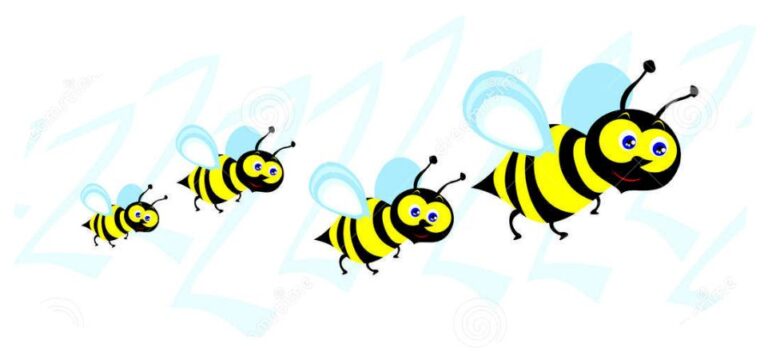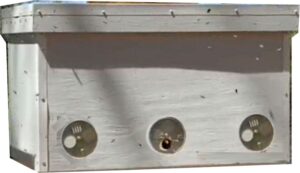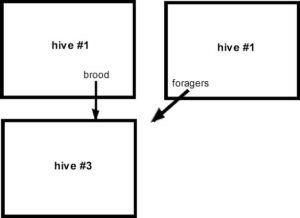Splits are also called ‘artificial swarms’.
Artificial swarming does what the honeybees are trying to do naturally: to prevent overcrowding by swarming i.e. self-splitting the colony so that they can establish an additional new colony elsewhere and be fruitful and multiply.


With uncontrolled natural swarming, only around 25% of the swarms survive. With artificial swarming or splits, the beekeeper can mitigate the risks and significantly improve the survival chances.
Splits are a regenerative way to grow the apiary. Regenerative or natural beekeeping is focused on promoting well-being within the hives, minimizing unnecessary disturbances, eliminating anything unnatural like pest treatments or artificial selection of queens and in our case any supplemental sugar-feeding.
By splitting the hives, we can keep our bees strong and healthy and enable the number of colonies to grow organically. Making splits allows us to maintain advantageous traits in honeybees naturally without artificial genetic manipulations.
For strong colonies that started making drone brood we make splits ~2 weeks after expanding the brood [~May 3 in Zone 5] nest IF there’s lots of capped and uncapped brood – eggs and larvae. The presence of drone brood is also a good indicator for splitting time.
Conditions for successful split: (1) Good temperature ~70F degrees daytime and around 60F during the night (2)good nectar flow (3) Strong colony with lots of capped and uncapped brood.
Equal Split (aka Half Split) : from 1 hive to 2 hives
1. Before Equal Split: only the central entrance is open. A single strong growing colony using the full beehive.

2. After Equal Split: only left & right entrances are open. Two smaller colonies are separated by a central divider board.

Procedure for Equal Split
Splitting the colony in the same hive allows the 2 resulting colonies to share warmth and conserve resources until Spring is well underway. After that you can move the split to its own hive.
Take every other brood frame and every other honey frame and move it to the opposite sides of the hive. Both sides should have frames with eggs, larvae, and capped brood. 3-4 frames per each side of the split. Place a solid divider between the two halves so that the bees cannot travel between the sides. Seal any gaps in the divider board (e.g. using warmed up propolis). Open respective entrances on either end.
For fully equal split:
Advantages of equal split (our preferred way to split): after the split, both colonies will have all of the generations of honey bees present – from larvae to nurse bees to foragers. According to the study below, without learning from an older generation of foragers by observation, the newly hatched foragers that did not have ‘older teachers’ will keep making a lot of mistakes with signalling the distance to foraging resources.

Layens’ 2-to-3 Split borrows resources from 2 existing (old) strong beehives #1 and #2 in order to create a new colony in hive #3. The advantage of this type of split: fewer resources 1/3 vs 1/2 are taken away from existing established colonies.
Disadvantage of the above method of splitting: no nurse bees (at least initially ) in hive#3.
Modified Layens 2-to-3 Split:
As step one, Hive #3 receives EVERY 2nd frame from hive#1 – this time WITH BEES! After which both boxes are closed (with queen excluder setting).
Where’s the queen? 3-5 hours after closing the lids, compare the behavior of the bees in hive #1 vs hive #3.
Bees in queen-less hive will be (according to Layens description) “disoriented”- flying aimlessly about, crawling on walls and going back in, instead of purposefully foraging.
Once the queen-less hive is determined, deal with it as above with hive#3.
Now, hive #3 will have nurse bees, brood and foragers (from hive #2).
~11 days later queen-less hive will have several queen cells that can be used for grafting and adding good genetics to your apiary!
